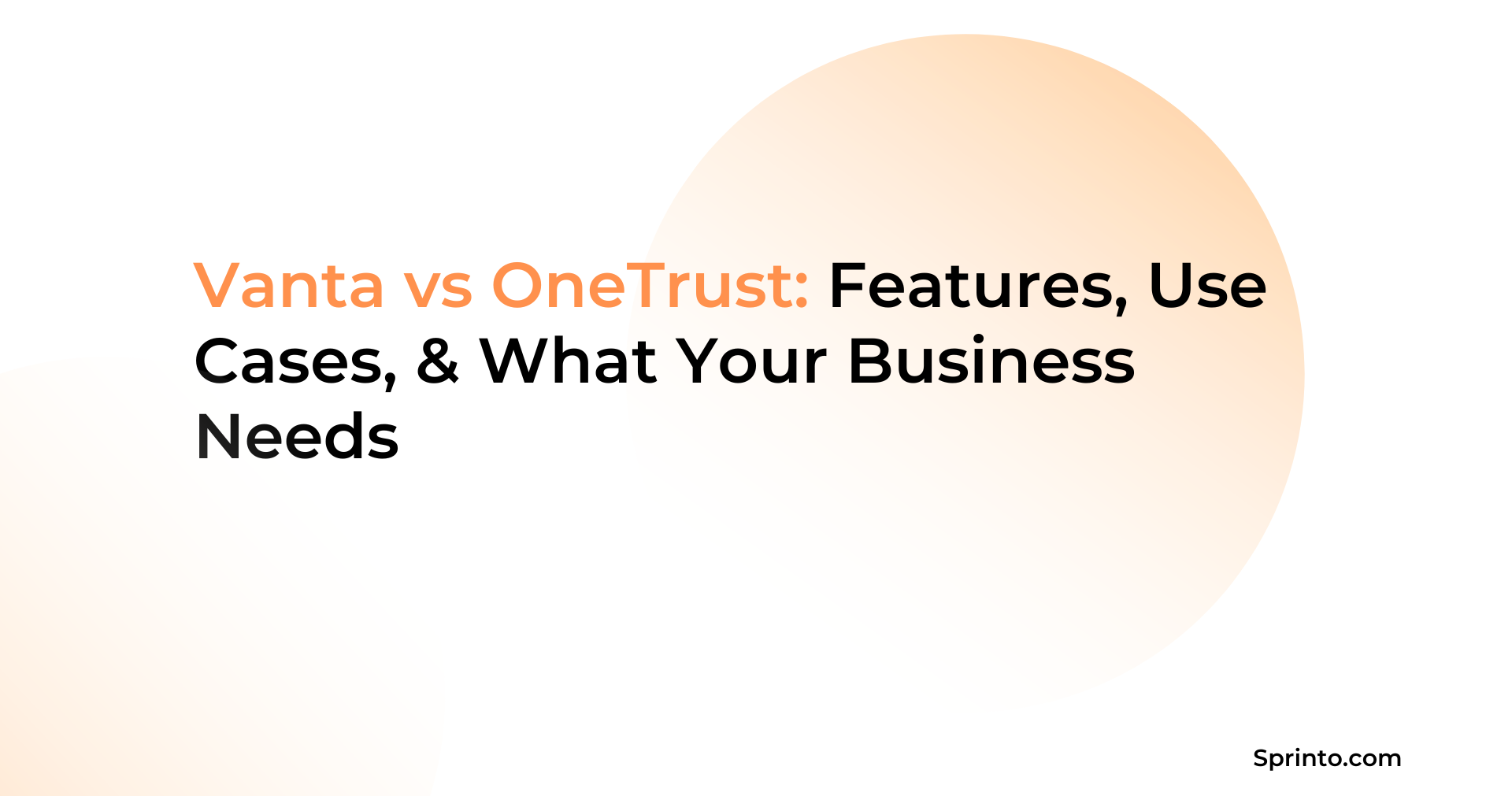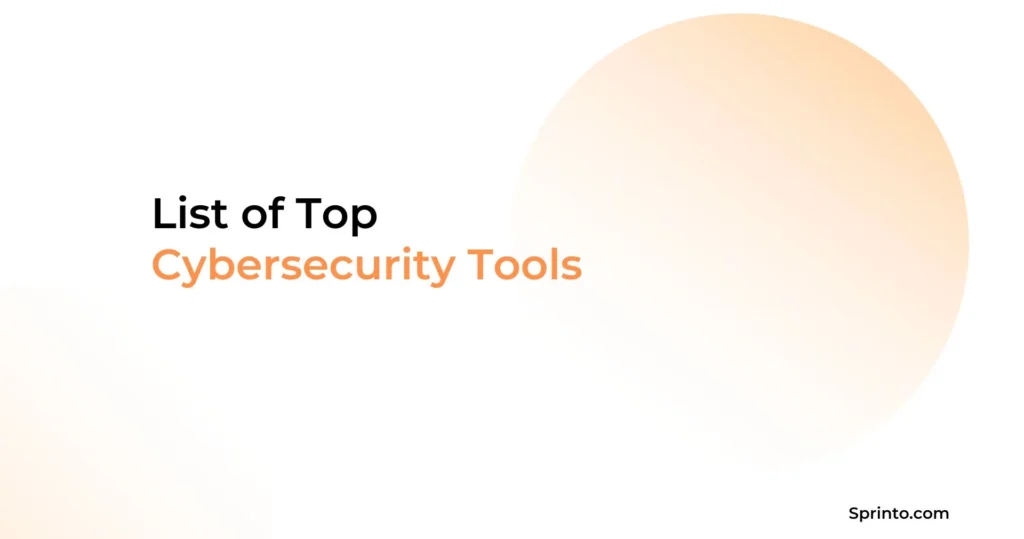IBM reports that the average cost of a data breach increased to $4.9 million, marking a 10% year-over-year rise. Data breaches are becoming common. And companies are paying the price.
With such a pressing necessity, CTOs and CISOs look for solutions to help them get compliant. Vanta and OneTrust are names that come up often.
Both platforms take very different routes. OneTrust is designed for privacy, vendor management, and regulatory workflows. Vanta is built for security-first teams preparing for SOC 2 and ISO 27001 audits.
In this article, we’ll compare two platforms across key features, integrations, pricing, and more to help pick the right trust management platform.
| TL;DR Vanta is built for fast-moving tech teams focused on SOC 2, ISO 27001, or HIPAA. It offers deep integrations, real-time alerts, and automated evidence collection for security audits. OneTrust is designed for privacy, consent, and vendor risk management. It supports global frameworks like GDPR and CCPA, with features like DSAR workflows, consent banners, and SLA tracking. Vanta fits engineering-led compliance in startups. OneTrust suits legal and privacy teams in enterprises with complex data governance needs. |
Quick comparison: Vanta vs OneTrust
| Factor/Aspect | Vanta | OneTrust |
| Primary Use Case | For Audit readiness: SOC 2, ISO 27001, HIPAA) | For Privacy management (GDPR, CCPA), vendor & policy workflows |
| Best For | Security, DevOps, Compliance Teams | Legal, Privacy, GRC, Procurement Teams |
| Framework Coverage | SOC 2, ISO 27001, HIPAA, PCI DSS | GDPR, CCPA, LGPD, CPRA, ISO 42001 |
| Automation Focus | Evidence collection, policy enforcement | Consent mgmt, DPIAs, vendor assessments |
| Integrations | AWS, Azure, GCP, Okta, GitHub, CrowdStrike, Jira | Salesforce, Workday, SAP, TrustArc, ServiceNow |
| Real-time Monitoring | Yes | Limited (mostly workflow-driven) |
| Market Focus | Mid-market, scaleups, tech-first organizations | Enterprise-heavy, privacy-first organizations |
Security leaders usually turn to platforms like Vanta or OneTrust when spreadsheets and manual tracking start falling apart, whether that’s during audits, vendor reviews, or regulatory updates.
Vanta: A quick overview
Simply put, Vanta is a trust management platform. Often, startups and SMEs choose it to simplify security compliance.
Vanta offers over 50 integrations, connecting directly with your cloud stack (e.g., AWS, GCP, GitHub, Okta), which enables access monitoring, enforces technical controls, and automatically collects audit evidence.
Why choose Vanta?
Pick Vanta if your business:
- Has deep integrations with AWS, GitHub, Okta, GCP, and more
- Need Real-time alerts when controls fall out of compliance
- Runs a public trust center to share security posture and certifications
- Want fast onboarding (two weeks) without the need for consultants
OneTrust: A quick overview
OneTrust lets you manage consent, cookies, and data requests across regions so that your business stays compliant with laws such as GDPR and CCPA.
Why choose OneTrust?
You pick OneTrust if the business:
- Need a centralized dashboard for managing global frameworks (GDPR, CCPA, LGPD)
- Want to leverage out-of-the-box templates for DSARs, breach reports, and impact assessments
- Require consent banners, cookies, and preference centers for websites and apps
- Follows Vendor assessment workflows, SLA tracking, and automated questionnaires
Vanta Vs OneTrust feature comparison
Features determine how a compliance tool works in practice.
Teams working across frameworks or tight audit cycles can’t afford tools that lack automation, visibility, or evidence tracking.
That’s why it’s worth breaking down what Vanta and OneTrust offer under the hood.
| Feature Category | Vanta | OneTrust |
| Time to Compliance | Fast SOC 2/ISO 27001 setup. Ideal for startups | Slower setup, but handles complex, multi-framework needs |
| Framework Coverage | Limited (SOC 2, ISO 27001, HIPAA) | Extensive (SOC 2, ISO, GDPR, CCPA, PCI DSS, ESG, etc.) |
| Automation | Pre-built integrations for common SaaS stacks | Customizable workflows, rules engine, and advanced automations |
| Audit Readiness | Strong for basic audits with pre-vetted auditors | Built-in evidence workflows and granular audit controls for enterprise |
| User Experience (UX) | Clean, easy-to-use interface | Complex, modular, steep learning curve |
| Risk Management | No integrated IRM, vendor, or third-party risk tooling | Full suite IRM, vendor risk, and privacy program management |
| Policy Management | Basic templates, limited customization | Advanced lifecycle tools and policy automation |
| Support & Services | Basic support, limited to working hours and timezones | Dedicated account teams, 24/7 support (at a premium) |
| Scalability | Breaks down with complexity or multiple frameworks | Enterprise-grade scale with high configurability |
| Implementation Effort | Plug-and-play setup, but lacks depth | High effort upfront, but deeply configurable |
| Customization | Limited workflow and framework customization | Fully customizable controls, policies, reports |
Pricing comparison
| Plan Type | Vanta | OneTrust |
| Entry Plan | Core: ~$11,500/year (SOC 2 for startups) | CMP: ~$827/month (Consent management only) |
| Mid-Tier | Growth: ~$22,675/year (multi-framework readiness) | Privacy Suite: ~$3,680/month (data mapping, DPIAs) |
| Enterprise | Scale/Enterprise: Up to ~$80K/year (GRC bundles) | Modular pricing: Often exceeds ~$40K/year |
| Pricing Model | Tiered by business size + frameworks | Customized |
| Transparency | Partial (via AWS, partner resellers) | Low (custom quote, per module) |
Both solutions offer custom pricing. However, we’ve reviewed a few external sources to provide a rough estimate of how much they will cost.
Price check: Vanta
Vanta offers a tiered pricing model tailored for both startup readiness and full-scale enterprise GRC. If you’re primarily focused on SOC 2 compliance, you’ll likely begin with the Core or Plus plan.
- Core (Startups): Approx $11,500 per year for small teams (1–20 users) via AWS Marketplace. Or, expect to pay at least $ 10,000 for Vanta Pricing as a starting point.
- Growth: Moves up to around $22,675/year for more expansive compliance needs
- Plus (Startups): Adds deeper monitoring and more integrations.
- Scale / Enterprise: Custom pricing that can go up to $80K a year as well.
At the enterprise level, Vanta also pitches GRC bundling that automates policy controls, risk registers, and trust reports via Vanta AI.
Price check: OneTrust
OneTrust follows a modular pricing model where you pay based on the solutions you need. It provides flexibility for scaling, but it also means costs can escalate rapidly as you add capabilities.
Some of their featured plans are:
Consent Management Platform (CMP): Starts around $827/month for basic cookie consent management.
Universal Consent & Preference Management (UCPM): Advanced features for multi-domain and global preference centers.
- Privacy Automation has Base and Suite tiers. Price starts at $3,680 per month for the suite.
- Third-Party Risk Management also offers Base and Suite tiers, with customized pricing based on vendor volume.
- Tech Risk & Compliance also has pricing that is often combined with enterprise packages.
- AI Governance is a new offering. Also, cost is custom-quoted.
Making a choice
This decision rarely starts as a tool comparison. It usually begins with a pressure situation, such as a customer security review blocking a sale, legal teams pushing back on outdated privacy notices, or a lengthy vendor questionnaire from a potential client.
That’s when teams start weighing options like Vanta and OneTrust.
To make the right call, focus on two things: the frameworks you need to support and how your teams operate.
What frameworks do you need?
If your priority is audit readiness, say SOC 2, ISO 27001, HIPAA, or PCI-DSS — and your team wants to move quickly without wrangling spreadsheets, Vanta is built for speed and simplicity. It hooks into your systems, flags control failures, and helps you prepare for audits without piling on GRC overhead.
On the other hand, your operations may involve collecting and processing personal data across multiple regions, and aligning with laws like GDPR, CPRA, or LGPD. In that case, OneTrust becomes an obvious choice.
It gives legal, security, and privacy teams the tools to manage consent, monitor regulatory changes, and streamline compliance across jurisdictions.
What features fit your workflow?
If your engineers are quick with development and stack runs on AWS, GitHub, and Jira, you don’t want compliance slowing you down. Vanta slots into that motion. It gets into your systems, shows what’s out of place, and clears a path to audit-readiness without pulling devs into GRC busywork.
Now, suppose you’re dealing with privacy laws across regions. In that case, OneTrust gives you what spreadsheets and bolt-ons can’t: a way to handle consent, manage third-party risk, and process DSARs. It’s less about plugging into tools and more about structuring how privacy works across your business.
The best of both worlds at a lower cost
Vanta and OneTrust solve fundamentally different problems.
Vanta gives engineering-led teams a fast track to audit readiness, but it hits limits when privacy, scale, or complexity enter the picture. OneTrust offers robust data governance and regulatory coverage, but it demands time, cost, and dedicated GRC teams to extract value.
What if you didn’t have to choose?
Sprinto is the best of both worlds. The platform is engineered for modern compliance leaders who need the automation of Vanta and the framework breadth and control depth of OneTrust, without the bloat, silos, or overhead.
- Automate 95% of controls across 30+ frameworks: SOC 2, ISO 27001, GDPR, HIPAA, PCI DSS, and more
- Run multi-framework compliance from a single dashboard, no duplication, no copy-paste
- Map risk, policy, and evidence workflows across security, privacy, and vendors, with zero third-party tools
- Get audit-ready faster with real-time alerts, continuous monitoring, and auditor-facing dashboards
- Onboard in weeks, not months with no consultants, no hand-holding, no surprises
Sprinto is a compliance operating system built for speed, scale, and security. Ready to replace Vanta, OneTrust, or both?

Frequently asked questions
1. What is the key difference between Vanta and OneTrust?
Vanta is designed for fast, automated security audits: SOC 2, ISO 27001, and HIPAA readiness. OneTrust, on the other hand, focuses on privacy management at scale, helping enterprises manage GDPR, CCPA, and vendor risk programs.
2. Can I use Vanta or OneTrust for both security and privacy compliance?
You can, but with trade-offs. Vanta excels at security-first frameworks but has limited native privacy tooling. OneTrust handles privacy and risk workflows effectively, but it isn’t specifically designed for SOC 2 automation.
3. Do these platforms support multi-framework compliance?
Yes. Vanta supports frameworks like SOC 2, ISO 27001, HIPAA, and PCI DSS. OneTrust maps control across GDPR, CPRA, ISO 42001, and more. Sprinto covers a similar spread but with native multi-framework mapping that avoids duplication and reduces manual effort.
4. Can I switch from Vanta or OneTrust to Sprinto?
Yes. Teams often migrate to Sprinto when they need more flexibility, wider framework support, or pricing that scales better. Migration involves mapping controls, reconnecting integrations, and recreating audit workflows. Also, Sprinto’s onboarding team typically handles this in weeks.
5. Which trust management platform is best for startups?
Startups often choose Vanta due to its fast onboarding and real-time monitoring. Sprinto is also gaining traction with high-growth startups for offering more flexible pricing and deeper automation. OneTrust is better suited for mature companies with dedicated legal and privacy teams.
Pansy
Pansy is an ISC2 Certified in Cybersecurity content marketer with a background in Computer Science engineering. Lately, she has been exploring the world of marketing through the lens of GRC (Governance, risk & compliance) with Sprinto. When she’s not working, she’s either deeply engrossed in political fiction or honing her culinary skills. You may also find her sunbathing on a beach or hiking through a dense forest.
Explore more
research & insights curated to help you earn a seat at the table.

















